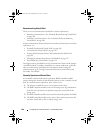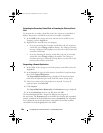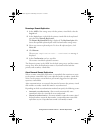
196 Configuration: Premium Feature— Remote Replication
Resynchronizing Virtual Disks
There are two resynchronization methods for remote replications:
• Manual resynchronization—See "Manually Resynchronizing Virtual Disks"
on page 200.
• Automatic resynchronization—See "Automatically Resynchronizing
Virtual Disks" on page 200.
For more information about synchronization and resynchronization in remote
replications, see:
• "Normally Synchronized Virtual Disks" on page 196.
• "Unsynchronized Virtual Disks" on page 199.
• "Setting Synchronization Priority and Synchronization Method" on
page 188.
• "Changing Synchronization Priority and Method" on page 197.
• "Resynchronizing Virtual Disks" on page 196.
You might need to periodically test the communication between the primary
virtual disk and the secondary virtual disk in a remote replication, especially
after resynchronizing virtual disks. For information about testing the
communication, go to Testing Communication between the Primary and
Secondary Virtual Disk.
Normally Synchronized Virtual Disks
In a normally synchronized remote replication, RAID controller module
owners manage the transfer of data from the primary to the secondary virtual
disk. In a normal remote replication, these events occur:
1
The primary virtual disk receives a write request from a host.
2
The RAID controller module owner on the storage array logs information
about the write operation to a replication repository virtual disk in the
storage array.
3
The RAID controller module owner writes the data to the primary virtual disk.
4
The RAID controller module owner starts a data transfer operation to the
secondary virtual disk on the secondary storage array.
book.book Page 196 Wednesday, June 8, 2011 5:01 PM


















